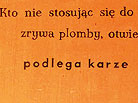exhibition of Danuta and Witold Urbanowicz
Danuta and Witold Urbanowicz belong to the generation which debuted during the time of political thaw in the second half of the 50s. They both studied at the Academy of Fine Arts in Cracow: Danuta (born 1932) — sculpture and painting, and Witold (born 1931) — painting. Since 1956 they have exhibited together with their friends who later would create Nowa Huta Group. Since 1961 the Urbanowicz have belonged to the famous artistic formation of Cracow Group.
The beginnings of their artistic investigations are similar and concern the problem of the so-called matter paining. It was a kind of painting without painting. Danuta Urbanowicz made collages of metal sheets, clothes and hardened laces, while Witold sewed fragments of non-painting materials, later coming to making reliefs/palpable images with characteristic motives of runic writing.
Since the mid-60s Witold Urbanowicz have returned to the traditional skills and techniques of painting, starting another stage of his painting characterised with a big load of expression with the figurative cycle Animal Farm. All stages of his artistic career are characterised by the dialogue with current situation of art and the surrounding reality. In Urbanowicz’s painting critics saw a new and original interpretation of the tradition that was coming from Kandinsky and Witkacy.
Danuta Urbanowicz choices were different. In the 60s ready objects and literal quotations from reality appeared in her pictures, which were close to pop-art in a way. In next years she used the citations from reality in a different way, literally copying official printed matter and forms, what made her art close to the ideas of conceptualism. In recent years she has returned to the experiences of the ‘matter painting’, consistently keeping the axial geometry of composition.
The exhibition of Danuta and Witold Urbanowicz in Katowice is a selection of their works from over 50 years of their artistic activity, arranged proportionally (also in numerical sense, since Witold made a few times more works than his wife), and reflecting all the important stages of their career.
Curator: Jan Trzupek






